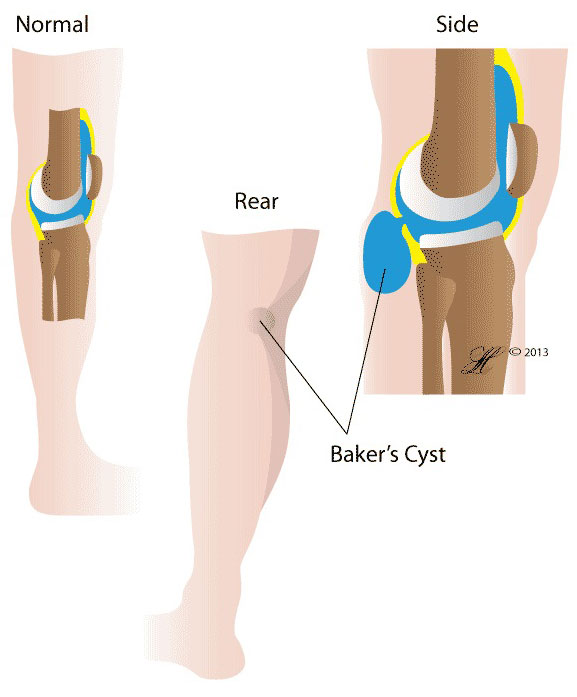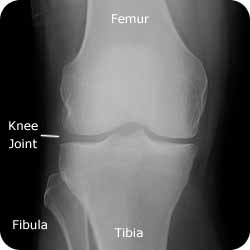A Baker’s cyst, also called a popliteal cyst, is a condition where a fluid filled bulge forms around the back of your knee.
It can form when you have a tear in your meniscus. The meniscus is a special type of cartilage in the knee which functions as a shock absorber.
Baker’s cysts are commonly found in knees with arthritis.

Symptoms
Occasionally, a Baker’s cyst causes no pain and may go unnoticed. Nevertheless, you have have:
- Swelling behind your knee
- Stiffness
- Knee pain
Causes
There is a liquid called synovial fluid which is found in pouches in your knee called bursa. A valve-like system exists between your knee joint and the bursa on the back of your knee (popliteal bursa). This regulates the amount of synovial fluid going in and out of the bursa.
When the knee produces too much synovial fluid you can get a Baker’s Cyst. Some common causes are inflammation of the knee joint and knee injuries (cartilage tear).
Investigations

A X-ray of the Right Knee showing normal anatomy
Imaging tests, such as an ultrasound and magnetic resonance imaging (MRI) scans, can help diagnose a simple cyst. If your doctor is concerned about other conditions like blood clots in your leg or an aneurysm, they may recommended more tests. Also in some cases some fluid needs to be extracted from the cyst using a needle.
Complications
Sometimes a Baker’s cyst can burst leading to synovial fluid leakage into the calf region. This can cause a sharp pain in the knee, redness of the calf and swelling. These features mimic those of a blood clot in your leg. If you have swelling and redness of your calf, it is important to urgently see a doctor.
Treatment
Many times, no treatment is required and a Baker’s cyst will disappear on its own.
If the cyst is very large and causes a lot of pain, your doctor may use the following treatments:
- Physiotherapy- Methods such as Icing the area, using a compression bandage and using crutches can help. Strengthening the muscles around your knee with gentle exercise may also help to alleviate your symptoms.
- Medication- You may get a corticosteroid injection into your knee which can reduce inflammation. It doesn’t always prevent recurrence of the cyst but it does ease the pain.
Typically though, doctors treat the underlying cause rather than the Baker’s cyst itself.
Even if after all the above have been tried and they do not work, you may need surgery to remove the cyst.
Seeking Advice
Your Family Doctor (GP)
Your Family Doctor will be able to diagnose and help treat your problem. He or she will be able to
- tell you about your problem
- advise you of the best treatment methods
- prescribe you medications
- and if necessary, refer you to Specialists (Consultants) for further treatment
If you’re experiencing pain and swelling behind your knee, see your doctor to determine the cause. Treating the underlying condition, such as arthritis or a cartilage tear, usually relieves the swelling and discomfort of a Baker’s cyst.
Though unlikely, a bulge behind your knee may be a tumour or a popliteal artery aneurysm rather than a fluid-filled cyst.
